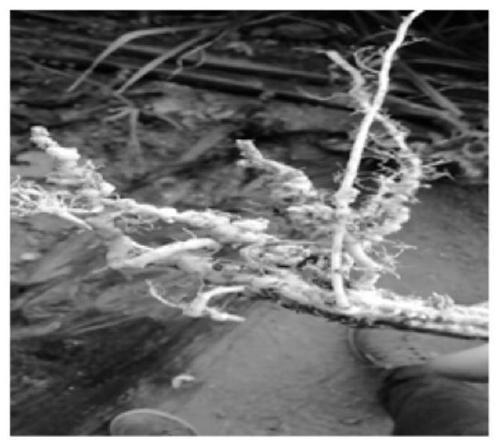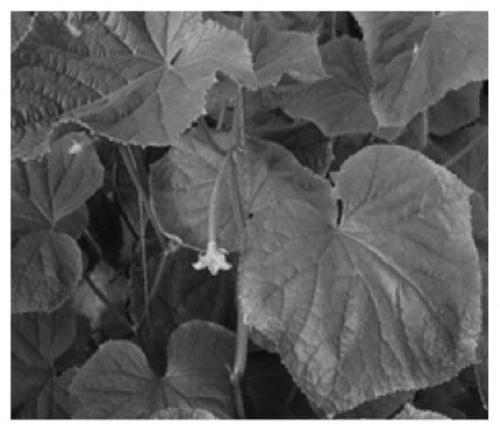Method for preventing and treating fruit and vegetable meloidogyne disease
A root-knot nematode disease and vegetable technology, which is applied in the field of prevention and control of root-knot nematode disease of fruits and vegetables, can solve the problems of poor stability and slow action of microbial preparations, etc.
- Summary
- Abstract
- Description
- Claims
- Application Information
AI Technical Summary
Problems solved by technology
Method used
Image
Examples
Embodiment 1
[0024] The method for continuous cropping of cucumbers in Bisiyingzi facility, Ningcheng County, Chifeng City, to prevent and control root-knot nematode disease. After the seedlings are slowed down, Paecilomyces lilacinus is applied.
[0025] In this example, single application of Kexian San and single application of Paecilomyces lilacinus were performed on cucumber seedlings, taking local fertilizer habits as a control, a total of 4 treatments, and each treatment was repeated 3 times. Residential Area 21m 2 , random arrangement, routine management.
[0026] Specifically, the single application of Kexian powder is to apply 4 bags of 1Kg / bag "Kesian powder" powder per mu on the basis of local fertilizer. , making furrows, mulching, punching, and planting.
[0027] Single application of Paecilomyces lilacinus refers to 1 bottle of "Paecilomyces lilacinus" water solution of 1000mL drip irrigation after the cucumber seedlings are slowed down, and 2 bottles of 1000mL "Paecilomyc...
Embodiment 2
[0036] The method of continuous cropping tomato in Heigoumen Village, Wenzhong Town, Hongshan District, Chifeng City to prevent root-knot nematode disease. The line is scattered for treatment, and the soil is directly rotated, planted, mulched, punched, and planted; after the tomato is planted, root-knot nematode occurs, and "Paecilomyces lilacinus" and avermectin are used for root irrigation.
[0037] In this embodiment, the single application of Paecilomyces lilacinus and the single application of abamectin were performed on the tomato seedlings as a control, a total of 3 treatments, and each treatment was repeated 3 times. Residential Area 21m 2 , random arrangement, routine management.
[0038]The specific method of using "Paecilomyces lilacinus" and avermectin for root irrigation treatment is (amount per mu). After the tomato is planted and the seedlings are slowed down, use 2 bottles (1000mL / bottle) of "Paecilomyces lilacinus" for the first time. Mix water with 180Kg w...
Embodiment 3
[0048] Methods of controlling root-knot nematode disease by continuous cropping tomato in Saliba Facility Shed Area, Aohan Banner, Chifeng City. The specific operation is: sprinkle Kexian powder before the field rotation, rotate the ground, make a furrow, cover the film, punch holes, and plant; apply 2 bags (1Kg / bag) of Kexian powder per mu; after the tomato is planted, Root-knot nematode disease, use "Paecilomyces lilacinus" and abamectin for root irrigation treatment.
[0049] In this embodiment, the single application of Paecilomyces lilacinus and the single application of abamectin were performed on the tomato seedlings as a control, a total of 3 treatments, and each treatment was repeated 3 times. Residential Area 21m 2 , random arrangement, routine management.
[0050] The specific method of using "Paecilomyces lilacinus" and abamectin for root irrigation treatment is (amount per mu). Mectin drip irrigation combination is used for drip irrigation, and the amount of ea...
PUM
 Login to View More
Login to View More Abstract
Description
Claims
Application Information
 Login to View More
Login to View More - R&D Engineer
- R&D Manager
- IP Professional
- Industry Leading Data Capabilities
- Powerful AI technology
- Patent DNA Extraction
Browse by: Latest US Patents, China's latest patents, Technical Efficacy Thesaurus, Application Domain, Technology Topic, Popular Technical Reports.
© 2024 PatSnap. All rights reserved.Legal|Privacy policy|Modern Slavery Act Transparency Statement|Sitemap|About US| Contact US: help@patsnap.com










